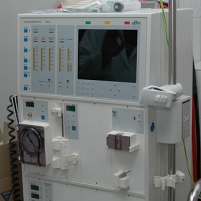Why Do Dialysis Patients in U.S. Die More Frequently than in Other Countries?
Thursday, December 09, 2010
 Hemodialysis Machine (photo: Wikipedia)
Hemodialysis Machine (photo: Wikipedia)
Medicare spends more than $20 billion a year to provide dialysis to patients with kidney disorders—about $77,000 per patient. This expenditure is higher than what any other country in the world spends on dialysis, and yet the United States owns one of the highest mortality rates for dialysis care among developed countries. Why?
For starters, Medicare often covers dialysis treatment in clinics with “shockingly poor” conditions, writes Robin Fields of ProPublica. Of the 1,500 clinics from across the nation that were inspected over a seven-year period, almost half were found to have “filthy or unsafe” facilities. Problems discovered included blood-stained chairs, walls, floors or ceilings.
At one clinic in North Carolina, a staff member handed a patient a can of bug spray after the patient complained about the prevalence of ants.
“Hundreds of clinics were cited for infection-control breaches that exposed patients to hepatitis, staph, tuberculosis, and HIV,” wrote ProPublica.
In many cases, patients died or were hospitalized after they began to hemorrhage because staffers failed to follow safety guidelines involving dialysis needles or tubing.
-Noel Brinkerhoff
“God Help You. You're on Dialysis.” (by Robin Fields, ProPublica)
- Top Stories
- Unusual News
- Where is the Money Going?
- Controversies
- U.S. and the World
- Appointments and Resignations
- Latest News
- Trump Goes on Renaming Frenzy
- Trump Deports JD Vance and His Wife
- Trump Offers to Return Alaska to Russia
- Musk and Trump Fire Members of Congress
- Trump Calls for Violent Street Demonstrations Against Himself






Comments